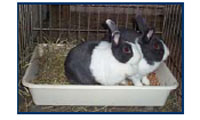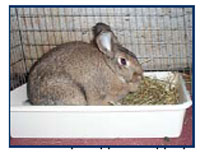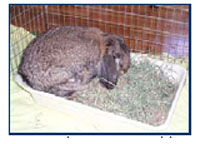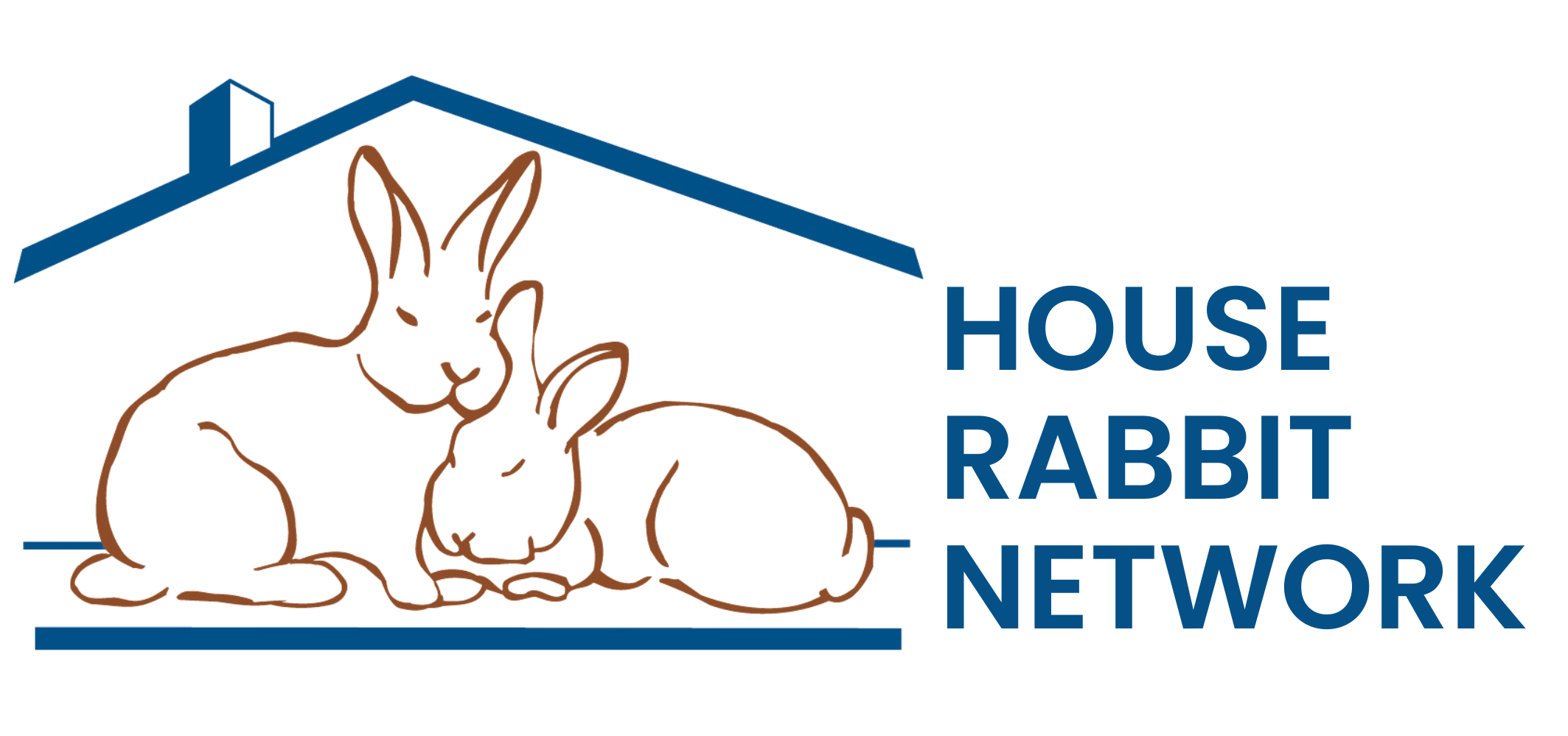The Basics of Litterbox Training
People who are unfamiliar with the concept of companion rabbits are often surprised to learn that rabbits can be trained to use a litter-box. Actually, this training is relatively easy. Altered adult rabbits usually choose a specific corner of their cage or other space to designate as their bathroom. Litter-box training is often as easy as simply placing the litter-box there.
Supplies
There are many options for both litter-boxes and litters available on the market today. What works well for one rabbit may be a disaster for a different rabbit. What works best for you will be a function of your rabbit’s preferences and the options available in your area. Start simple and let your rabbit lead the way.
Litter-boxes come in a variety of sizes and shapes and with a variety of options to help address different training problems. The standard rectangular litter-box is a good starting point for most rabbits. The size you choose will be a function of the space available in your rabbit’s cage, condo, or room and your rabbit’s size. For small breeds, the medium box may be big enough. The large-size litter-box works best for rabbits from five to ten pounds. The extra-large or giant may be best for larger breeds, although my French Lop, Thumper, does fine with the large litter-box. Smaller breeds may do better with a shallower litter-box that is easier for them to hop in and out of while larger breeds may do better with a deeper box. Rubbermaid dishpans can also be used as litterboxes and come in a variety of sizes.
For most rabbits, I recommend using a layer of newspaper between the litter-box and the litter itself. The exception would be for a rabbit who insists on shredding the soiled newspaper and tossing it outside the box! Newspaper is both inexpensive and absorbent and can help reduce the amount of litter you need to use. If you don’t subscribe to a newspaper, you probably have a friend or neighbor who would be happy to let you dispose of his papers! If you are willing to change the litter-box more frequently, you may be able to get by with newspaper alone with no need to purchase – and dispose of – expensive and often heavy litters.

There are many rabbit-safe litter alternatives to choose from. You my not be able to find all options in all parts of the country. However, you should be able to find one that fits your budget, life-style, and physical limitations. Some of the most popular options include:
- Paper Pulp or Recycled Newspaper Litters Paper-pulp products (e.g., CareFRESH) and recycled newspaper litters (e.g., Yesterday’s News, Eco- Fresh) are absorbent and control odor well. They are safe if ingested (in reasonable quantities).
- Compressed Sawdust Pellets Wood stove pellets, available in many parts of the country for winter heating, make an economical, alternative to litters like Yesterday’s News. Most brands are safe, but a few contain lighter fluid, so be sure to ask about this and read the label (avoid anything that says “fastlighting,” no matter what a store clerk tells you!). If wood stove pellets are not available where you live, Feline Pine litter is a similar product. Both are absorbent and control odor well.
- Pelleted Plant Fiber Litter Cat Country is a pelleted litter made primarily from plant fibers. It is absorbent and controls odor well.
- Aspen Aspen litter comes in both a pelleted form (Aspen Supreme) and a shaved wood product that looks similar to pine and cedar bedding but is safe for rabbits. These litters are absorbent and control odors well.
- Food Pellets Some people use food pellets as litter. They control odor relatively well and are certainly safe for your rabbit to eat, though they may not be the best choice for an overweight rabbit. It is critical that wet pellets not be allowed to mold, since mold is extremely toxic to rabbits.
- Newspaper and/or Shredded Paper Newspaper and/or shredded paper provides an economical alternative to purchased litters. They are absorbent but do little to control odor, so boxes need to be changed more frequently than with other litters. If you like the idea of shredded paper, you may be able to get an ample supply from your employer. If he has any concerns about the “security risk” of sending the shredded paper home with you, remind him that you will be adding security since no one is going to attempt to reassemble it once your rabbits have used it!
For your rabbit’s health and safety, please avoid the following types of litter:
- Clumping Litters If your rabbit nibbles this type of litter, it is likely to clump in his digestive tract, causing an obstruction, which can lead to death.
- Pine and Cedar Shavings The fumes from pine and cedar shavings have been linked to both respiratory problems and liver damage in rabbits.
- CatWorks litter CatWorks has been linked to zinc poisoning in rabbits.
- Corn Cob Litter Like clumping litter, if your rabbit nibbles on it, corn cob litter can cause a lethal blockage.
- Clay litters Clay litters should be avoided unless you use a grated litter-box that prevents your rabbit from digging in the litter itself. Clay litters are extremely dusty, and the dust can cause respiratory problems. The deodorant crystals found in many clay litters are also toxic.
I highly recommend adding a generous handful of hay to your rabbit’s litter-box. Hay in the litter-box encourages two good habits – using the litterbox and eating hay. If the litter-box is large enough, your rabbit uses only one corner for a bathroom, and you keep a supply of fresh, dry hay in the box, this may be the only place your rabbit wants to go to eat hay! If your rabbit insists on urinating on the hay, see if you can find a way to hang a hay manger so it can be reached while he is in the litter-box.

Training
Rabbits adopted from a shelter or rescue group are often already litter-box trained. However, expect them to need some amount of retraining in their new surroundings. Even if your plan is to give your new companion full run of your house or apartment, it is best to start your rabbit out in a relatively small area. Too much freedom too quickly can be overwhelming and can lead to poor litter-box habits.
If your rabbit is already litterbox trained, start with the same type of litter-box and litter (unless it is dangerous) that he is used to – even if you plan to ultimately use something different. Place the litter-box in a corner of his cage, exercise area, or room. Rabbits have very definite opinions about how their living space should be arranged. If your rabbit chooses a different corner, it is much easier to move the litter-box than it is to change his mind about where it should be!
Some rabbits immediately begin using the litter-box once it is placed where they want it. For others, training requires more work. In general, younger rabbits and unspayed females are more difficult to train. Here are some things to try if your rabbit insists on urinating outside the litter-box, even after you have placed it where he has chosen to go:
- Put the paper towel you used to clean up the urine in the litter-box to help communicate that this is where he should “go.”
- If you have a multiple-rabbit household, a “slightly used” litter-box from a well trained rabbit may encourage your rabbit to use the box – rabbits like to urinate in the same place as another rabbit, as a way of claiming territory. If the rabbit you are training is going to be bonded with another, swapping litterboxes back and forth can help with both litter-box training and bonding!
Caution: There is some risk of spreading e. cuniculi and coccidian through shared litter-boxes, so use this approach only if you feel confident that both rabbits are in good health. - Increase the number of litter-boxes in your rabbit’s space. You may need to start with as many as five or six to improve your rabbit’s chances of using one of them. Most rabbits will eventually choose one or two to use, and you can gradually remove the extras.
- Spend time watching your rabbit play. If he heads to a corner without a litter-box and starts to raise his tail, clap your hands, say “no” and gently guide him to the nearest litter-box. Once he goes in the box, reward him with his favorite treat.
If you simply cannot get your rabbit to use a litter-box – or if a trained rabbit suddenly stops using his box – schedule a trip to the vet to rule out physical problems: urinary tract infections and bladder sludge can both cause incontinence; arthritis and e. cuniculi can make it difficult or painful for your rabbit to get in and out of the litter-box. Appropriate medical treatment along with possible modifications to the litter-box itself (e.g., using a box with one low side for easy access) will often solve the litter-box training problem. If no health problems are found, ask yourself whether changes in your household might be upsetting your rabbit. Rabbits are creatures of habit, and if you are spending less time with him, have changed your daily routine, or have added another animal to your home, your rabbit may express his displeasure by refusing to use his litter-box. Try spending extra time reassuring him that he is still an important part of your family.

Once your rabbit becomes dependable about using the litter-box in a small area, you can gradually expand his play area. Usually he will return to his cage or room to use the litter-box. Sometimes he will choose a spot in his expanded area to use as a “second bathroom.” If this happens, consider putting a litter-box there as well.
It is best if you can allow your rabbit to move freely between his cage or room and his expanded play area. However, this is not always practical. If you have to carry your rabbit to his play area – or if you are moving your rabbit to a new living area – he may initially be reluctant to use the litter-box, preferring to wait until he is back in his own space. When I brought Stormy home from the shelter, he worried me because he produced nothing for a couple of days. Finally, he chose a spot in my hallway rather than the litter-box in my bathroom. I was so thrilled to see normal bodily functions, I put an identical litter-box in the spot he had chosen. Because he spent the night and much of the day confined to the bathroom, he began using the litter-box in there as well. Gradually he became used to using it and in a few weeks we were able to remove the litter-box from the hallway.
As I mentioned earlier, rabbits seem to have definite opinions about where their litter-box should be placed. While most prefer a corner of their area, this is not true for all. Dante would always move his litter-box to roughly the middle of his pen. Many rabbits who move the litterbox will proceed to urinate in the corner where it once was. In these cases you will want to find a way to anchor the litter-box in place, usually by clamping it to the side of the cage or pen. For rabbits whose area is a room, it may take some creativity to find a way to keep him from moving the litter-box. In Dante’s case, it was not necessary to anchor the litter-box. He is excellent about using it – he just wants to exercise his right to move it to the middle of his area!
Multi-Warren Homes
If you have more than one group of rabbits in your home, you may see territorial marking (usually with fecals) by one or both groups along shared borders such as baby gates or in shared exercise areas. Even neutered/spayed rabbits are somewhat territorial, and such marking should be considered normal. One way to address this problem is to minimize the number of shared borders. In my home, groups have their own rooms that border on the hallway, which is usually a “rabbit-free” zone. Another way to reduce the problem is to experiment with rearranging warrens so that the more territorial groups are not housed directly next to each other.
Litter-box Cleaning
You and your rabbit will need to negotiate how often his litter-box should be cleaned. Some rabbits like immaculate litter-boxes and would love it if you cleaned after every use. Others may be confused if you change it too often. Urine and poop in the litter-box encourage some rabbits to use it again. If you change it too frequently, it may give them the impression that they are not supposed to use it!

Training Problems
If your rabbit seems to kick a lot of litter out of his box, start by adding a snap-on frame to the box. This makes the box a bit taller to hop in and out of, but often solves the problem of inadvertently kicking litter (and poop) out of the box. You can also try switching to a different type of litter. If all else fails, you may want to try one of the hooded (enclosed) litter-boxes. However, some rabbits will not use this type of box, perhaps out of fear of being “trapped in a corner.” A more enclosed litter-box also tends to trap odor and will probably need to be cleaned more frequently.
A second common problem with the simple rectangular litter-box is that your rabbit may back up so far that he urinates over the edge of the litter-box. A deeper litter-box, with or without a snap-on frame, will often solve this problem. If your rabbit has difficulty getting into a deeper – or framed – litter-box, high-backed litter-boxes are available in both corner (triangular) styles and standard (rectangular) styles. These boxes also feature a very low entryway on the opposite side, making them ideal for rabbits with mobility problems and for use after surgery.
A third, less common, problem is the rabbit who intentionally digs all the litter out of his box. Some rabbits will then urinate in the empty box, getting both feet and tail urine-soaked. For these rabbits, you can place a piece of hardware cloth, cut to litterbox size, on top of the litter. Or you can purchase a “sifting” litter-box, then line the solid portion with newspaper and litter and place the grated portion on top of the litter. Both of these approaches allow urine and some poops to pass through to the litter and keep your rabbit from making as much of a mess.
by Kathy Smith
